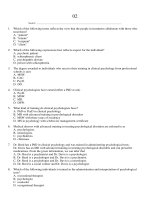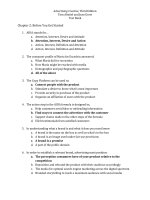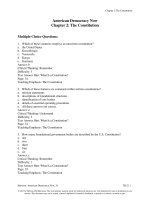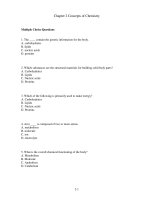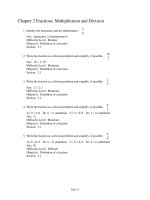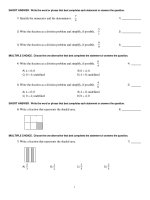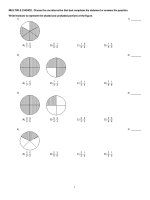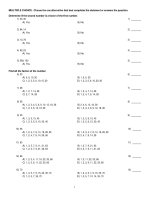FOCUS on college success 3rd edition staley test bank
Bạn đang xem bản rút gọn của tài liệu. Xem và tải ngay bản đầy đủ của tài liệu tại đây (98.79 KB, 4 trang )
Chapter 2—Learning About Learning
1. According to the text, the ability to learn is
a. established by the time you are 18 years of age.
b. enhanced by physical exercise.
c. limited to those who are naturally gifted.
d. enhanced by meditation.
ANS: B
PTS: 1
2. The VARK, Myers-Briggs Type Indicator, and SuccessTypes Learning Style Type Indicator are
a. tests that tell you exactly how to be successful in college.
b. assessments that provide you information about what career is best for you.
c. assessments that provide you information about your learning style.
d. tests that tell you what major to choose.
ANS: C
PTS: 1
3. According to Gardner, "The ability to find and solve problems and create products of value in one or
more cultural settings" is the definition of:
a. brain-based learning.
b. knowledge.
c. intelligence.
d. naturalistic intelligence.
ANS: C
PTS: 1
4. Using intelligence-oriented study techniques means
a. re-writing your notes at least at least three times.
b. working with a tutor.
c. knowing and studying in the style of your particular type of intelligence.
d. keeping a journal.
ANS: C
PTS: 1
5. Dan sets aside time to study alone and in a quiet place. He uses that time to write a summary of the
chapter he just read in his Introduction to History class. From the list below, choose the types of
learning styles Dan is expressing:
a. extravert and kinesthetic.
b. introvert and visual.
c. introvert and read/write.
d. extravert and aural.
ANS: C
PTS: 1
6. Having the right amount of stress, being motivated from within, and searching for personal meaning
are all examples of:
a. neuroplasticity.
b. the best conditions for learning.
c. multiple intelligences.
d. flow.
ANS: B
PTS: 1
7. From the choices below, which is an example of sensing (as opposed to iNtuition), as described in
FOCUS?
a. looking for quick insights.
b. reading between the lines.
c. following instructions.
d. seeking out teachers who encourage independent thinking.
ANS: C
PTS: 1
8. Diane learns that her intelligence type is heavily skewed toward Naturalistic. Which of the following
careers might she be suited for?
a. anthropologist.
b. philosopher.
c. counselor.
d. actor.
ANS: A
PTS: 1
9. Fatima has completed reading this chapter and now determines how she studies charts and graphs,
listens to discussions, writes her notes, and then creates practice test questions and answers. Which
assessment best describes what she has learned?
a. Myers-Briggs Type Indicator (MBTI).
b. VARK.
c. SuccessTypes Learning Style Type Indicator.
d. None of these.
ANS: B
PTS: 1
10. Lilly completed the Success Types Learning Style Type Indicator. Her four-letter profile is ENFP.
Which combination of activities listed below would best suit Lilly's learning style?
a. Studying alone; memorizing facts; learning through debate; and having classes that are
very formal.
b. Studying with others; having opportunity for independent thinking; developing positive
rapport with her teachers; and working in energy bursts.
c. Studying in a quiet space; working with theories; critiquing ideas; and planning her work
in advance.
d. Studying with quiet music in the background; memorizing lists of details and facts; using
logic; and taking charge of her study group.
ANS: B
PTS: 1
11. Among the choices listed, choose the best strategy for improving intelligence:
a. taking advantage of opportunities to develop our weaker intelligences.
b. balancing our efforts between developing our strongest and weaker intelligences.
c. exercising, eating well, and attending classes.
d. putting efforts into developing our weaker intelligences; our strong intelligences will
develop on their own.
ANS: B
PTS: 1
12. According to the text, being multimodal gives most of us ____ in the way we learn.
a. difficulties
b. strength
c. confusion
d. flexibility
ANS: D
PTS: 1
13. Gilda just completed the VARK. Her scores were 2 (V), 4 (A), 3 (R), and 8 (K). Choose the test
preparation strategy below that would allow Gilda to use her preferred sensory channel.
a. Writing practice answers and sample paragraphs.
b. Imagining she is talking with the teacher as she answers the questions.
c. Reading her notes silently over and over.
d. Creating diagrams to illustrate answers to practice questions.
ANS: A
PTS: 1
14. Cindy has a difficult time understanding why she is so successful in some classes and struggling in
others. After reading this chapter, you discuss three types of intelligences with her. What three might
you discuss to help Cindy?
ANS:
Possible responses include:
Hands-on learner
Linguistic
Logical mathematical
Spatial
Bodily-kinesthetic
Musical
Interpersonal
Intrapersonal
Naturalistic
PTS: 1
15. According to the text, there are eight types of multiple intelligences. Name two, and then provide an
example for each.
ANS:
Possible responses include:
Linguistic: telling a story; reading
Logical-mathematical: completing a puzzle; putting things into categories
Spatial: Doodling or drawing; working with a map
Bodily-kinesthetic: practicing a skill by doing it; role-playing
Musical intelligence: making a song out of a list of items or ideas; playing music in the background
while studying
Interpersonal: participating in a study group; tutoring or teaching others
Intrapersonal: journaling; making a list of personal strengths and weaknesses
Naturalistic: taking time for a walk to reflect on a lecture; studying nature or wildlife (the
environment)
PTS: 1
16. Consider the information you gained through completing the VARK. What are three career paths that
would be suitable for your learning style? For each career path, provide at least one supporting
statement of why you believe that career path would be a good fit for your learning style.
ANS:
The response should be scored on how effectively the student defends the three careers. A high quality
response should be clearly stated and include at least three examples (one for each career) of how the
learning style would be supported by each stated career.
PTS: 1
17. Think of your Multiple Intelligences Self-Assessment. Which of the intelligences did you score
highest on? Describe how you can apply that particular intelligence to this course. Be sure to include at
least three vivid examples of how your intelligence could be used.
ANS:
This item should be scored on clarity, logic, and connection to the course.
PTS: 1
18. According to FOCUS, about 60% of the population is multimodal in terms of learning styles.
Multimodality allows for flexibility in learning. Why is flexibility in learning important? Name at least
three examples of flexibility in learning.
ANS:
Flexibility in learning is important because it increases the number of strategies that learners can use to
learn new ideas or skills and reinforce them. Examples of flexibility in learning could include: creating
a presentation from class notes and then recording it to listen to; meet with a study partner and write
example test questions and their responses; create an online or paper and pencil crossword puzzle or
other game from practice test questions that you've written; (see Figure 2.3 for more possibilities for
combining learning strategies).
PTS: 1
19. In FOCUS, Tony Schwartz wrote, "Our lives have been divided into smaller and smaller increments of
focus. We do more things than ever, but we've lost control of our attention." What is the key problem
to which he is referring?
ANS:
Multitasking.
PTS: 1
20. Based on all the reading in Chapter 2 of FOCUS, who or what has the greatest influence on your
ability to learn?
ANS:
You.
PTS: 1
